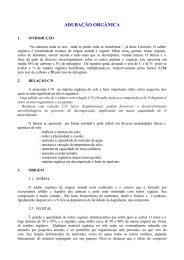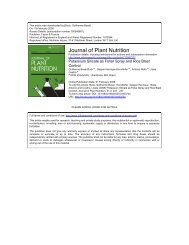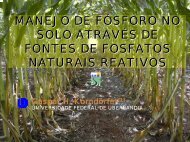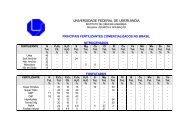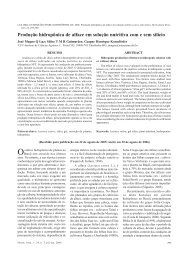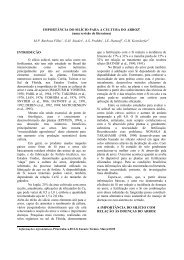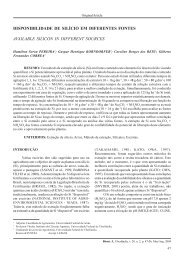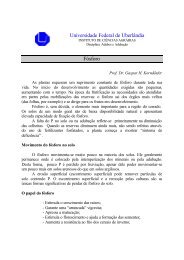Efficiency of Calcium Silicate and Carbonate in Soybean Disease ...
Efficiency of Calcium Silicate and Carbonate in Soybean Disease ...
Efficiency of Calcium Silicate and Carbonate in Soybean Disease ...
- No tags were found...
You also want an ePaper? Increase the reach of your titles
YUMPU automatically turns print PDFs into web optimized ePapers that Google loves.
2054 A. Nolla et al.calcium silicate <strong>in</strong>creased leaf Si concentration up to 1.70 fold, vary<strong>in</strong>g from0.34% to 0.55% if silicate was applied at doses <strong>of</strong> 0 or 12 mg ha −1 (Figure 1).These values were higher than those reported by Grothge-Lima et al. (1998)(0.02%–0.45%) after the application <strong>of</strong> 0 or 100 mg Si kg −1 (Si metasilicate—Na 2 SiO 3·5H 2 O) <strong>in</strong> nutrient solution. These differences could be expla<strong>in</strong>ed bythe sampl<strong>in</strong>g method adopted <strong>in</strong> each study. Here, the third leaf pair at flower<strong>in</strong>gstage (stage R 1 ), was sampled, whereas Grothge-Lima et al. (1998), sampledstem <strong>and</strong> leaves at stage V 1 . Therefore, a longer growth period was allowed, <strong>and</strong>the plant tissues analyzed could expla<strong>in</strong> the different Si contents between thetwo studies. Also, the <strong>in</strong>crease <strong>in</strong> Si content under the treatments where silicatewas applied was significant because the soil (Ustoxic Quartzipsamment) studiedhad low natural availability <strong>of</strong> Si (0.6 mg dm −3 ).The <strong>in</strong>crease <strong>in</strong> leaf Si concentration <strong>in</strong> soybean under the treatments wheresilicate was applied is desirable, as supply<strong>in</strong>g silicate has been shown to contributeto reduction <strong>of</strong> Fusarium solani (soybean sudden-death syndrome) <strong>and</strong>stem canker <strong>in</strong> soybean plants (Juliatti et al., 2003). In cucumber, Si acts <strong>in</strong> thehost tissue, affect<strong>in</strong>g signal<strong>in</strong>g between host <strong>and</strong> pathogen, which results <strong>in</strong> afaster <strong>and</strong> more extensive activation <strong>of</strong> plant defense mechanisms, probably asa function <strong>of</strong> phytoalex<strong>in</strong> production (Samuels et al., 1991; Chérif et al., 1994).The observation <strong>of</strong> downy mildew <strong>in</strong>cidence on soybean leaves at 47, 66,or 79 d after seed<strong>in</strong>g <strong>in</strong>dicated that the disease was not controlled <strong>in</strong> the calciumcarbonate plots (Figure 2). However, there was a reduction <strong>of</strong> downy mildew <strong>in</strong>cidenceunder the silicate treatments, especially at 47 d after seed<strong>in</strong>g (Figure 2a),from 85% (no silicate) to 65% (12 mg ha −1 calcium silicate), demonstrat<strong>in</strong>g theefficacy <strong>of</strong> Si <strong>in</strong> disease control <strong>in</strong> the first evaluation. This reduction probablyoccurred as a function <strong>of</strong> greater Si accumulation <strong>in</strong> soybean leaf tissue underthe silicate treatments (Figure 1). It is expected that, <strong>in</strong> cropp<strong>in</strong>g areas, thisreduction <strong>in</strong> disease <strong>in</strong>cidence after soil <strong>in</strong>corporation <strong>of</strong> calcium silicate couldalso result <strong>in</strong> a reduction <strong>in</strong> use <strong>of</strong> fungicide sprays, as well as lead to a greateryield due to the longer ma<strong>in</strong>tenance <strong>of</strong> photosynthesiz<strong>in</strong>g area.There was no difference <strong>in</strong> downy mildew <strong>in</strong>cidence 66 d after seed<strong>in</strong>g(Figure 2b); however, where calcium carbonate was applied, there was a trend<strong>of</strong> greater <strong>in</strong>cidence (90%–100%) than where silicate was applied (81%–92%).This result demonstrates, once aga<strong>in</strong>, that the application <strong>of</strong> calcium silicate wasmore effective for disease control, possibly due to the activation <strong>of</strong> biochemicalmechanisms <strong>of</strong> plant defense (Korndörfer et al., 2004). In the last evaluation(Figure 2c), 79 d after seed<strong>in</strong>g, downy mildew <strong>in</strong>cidence was 100% under thelim<strong>in</strong>g treatment. Similarly, under the silicate treatments, disease <strong>in</strong>cidence wasnear 100%, vary<strong>in</strong>g from 96% to 100%. Accord<strong>in</strong>g to Korndörfer et al. (2004),the <strong>in</strong>corporation <strong>of</strong> silicate <strong>in</strong>to the soil does not prevent disease <strong>in</strong>cidence;however, as observed here, it can delay disease onset <strong>and</strong> reduce its <strong>in</strong>cidenceearly <strong>in</strong> the growth season. This action is highly desirable, especially consider<strong>in</strong>gthat disease control with fungicides can be delayed, <strong>and</strong> the number <strong>of</strong>sprays reduced, thus reduc<strong>in</strong>g production costs.



